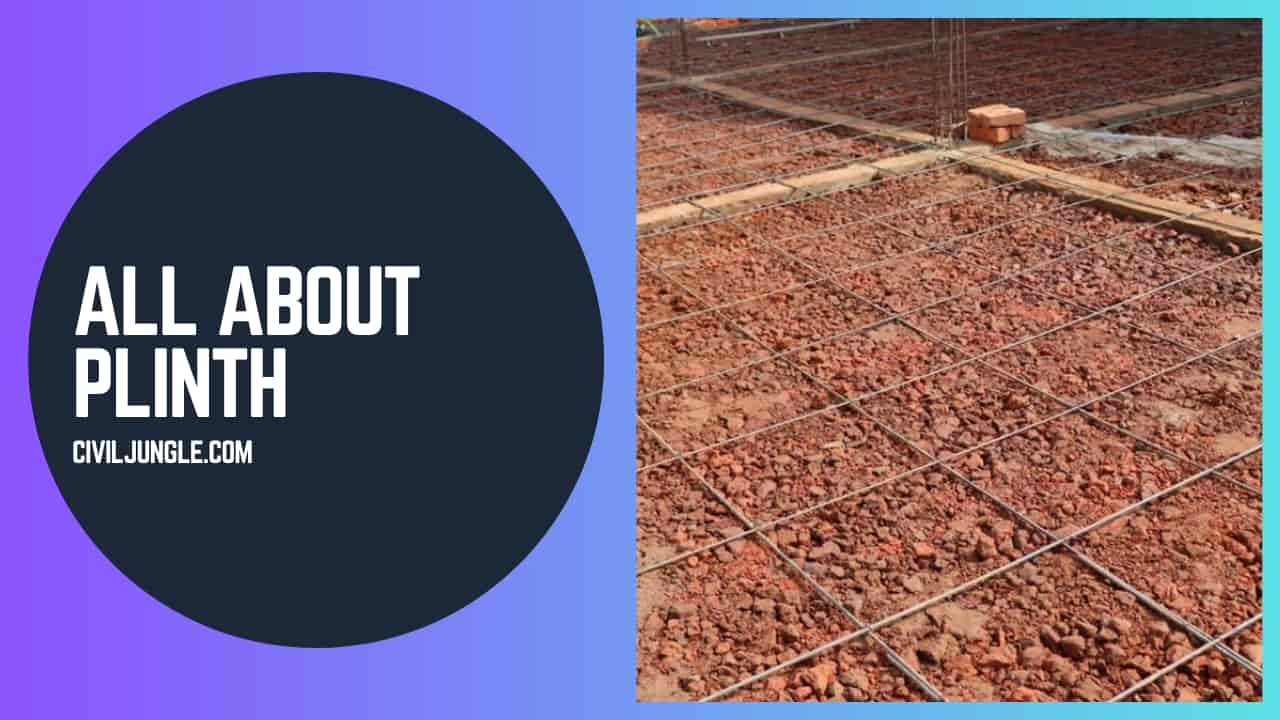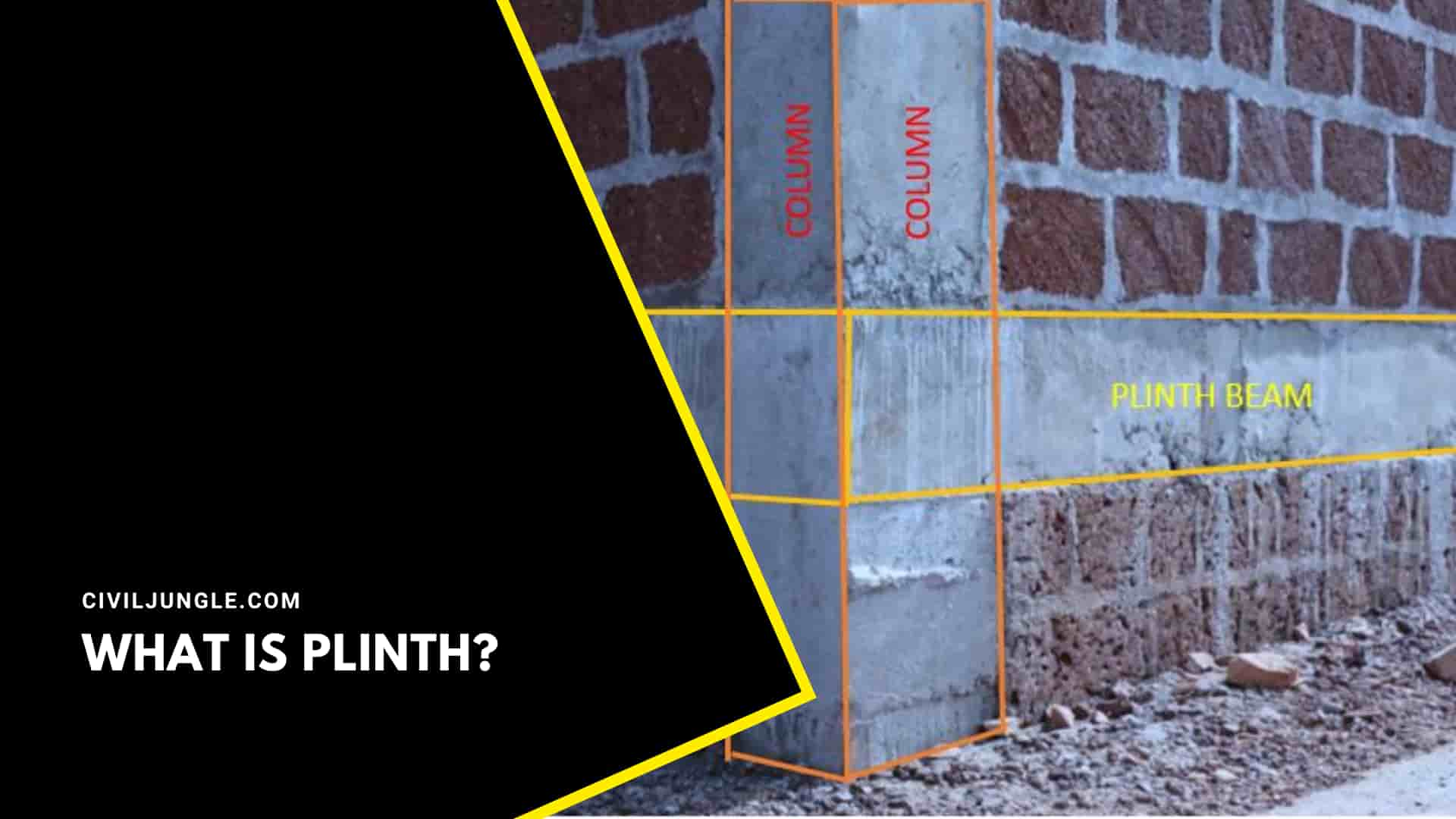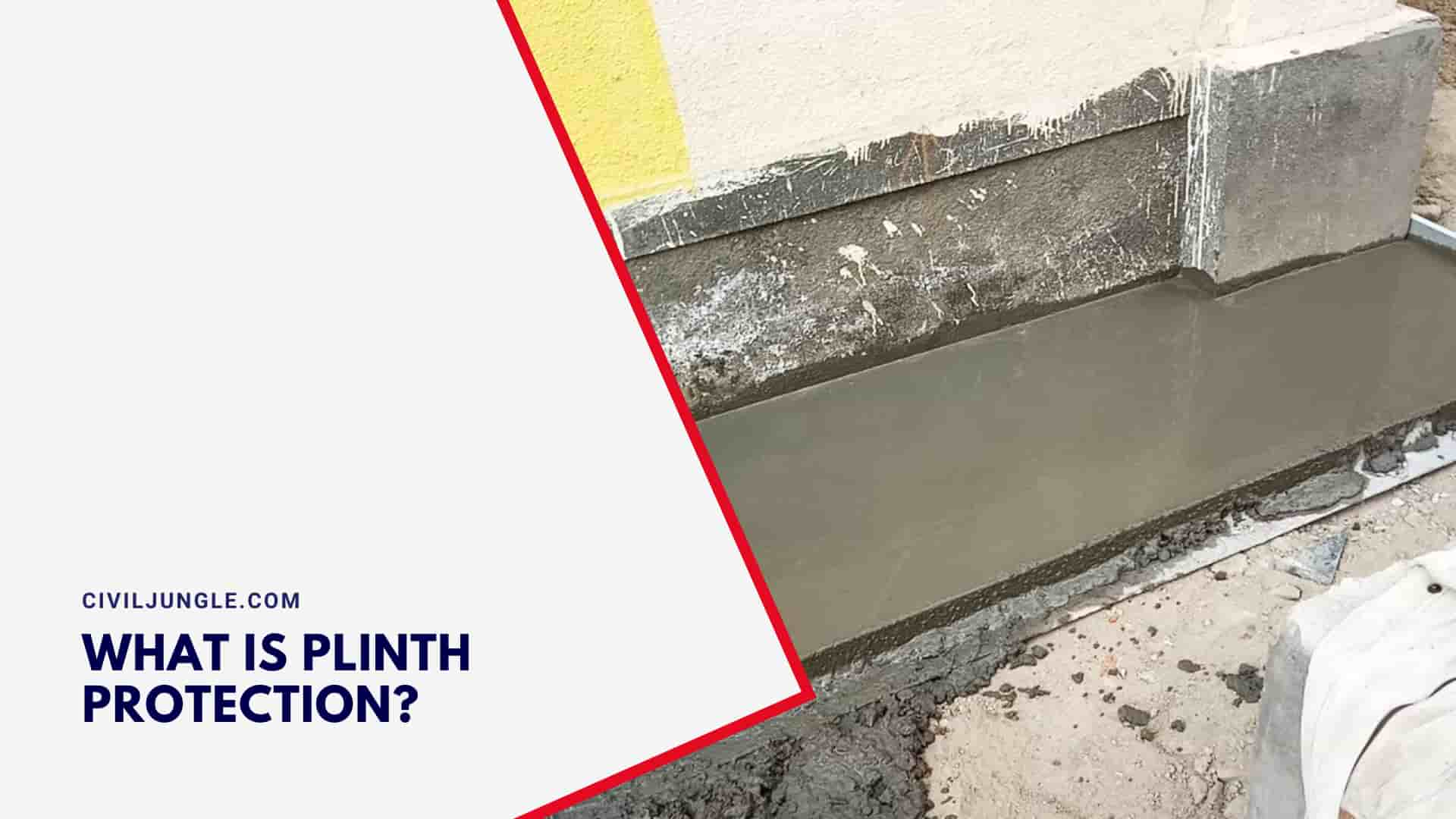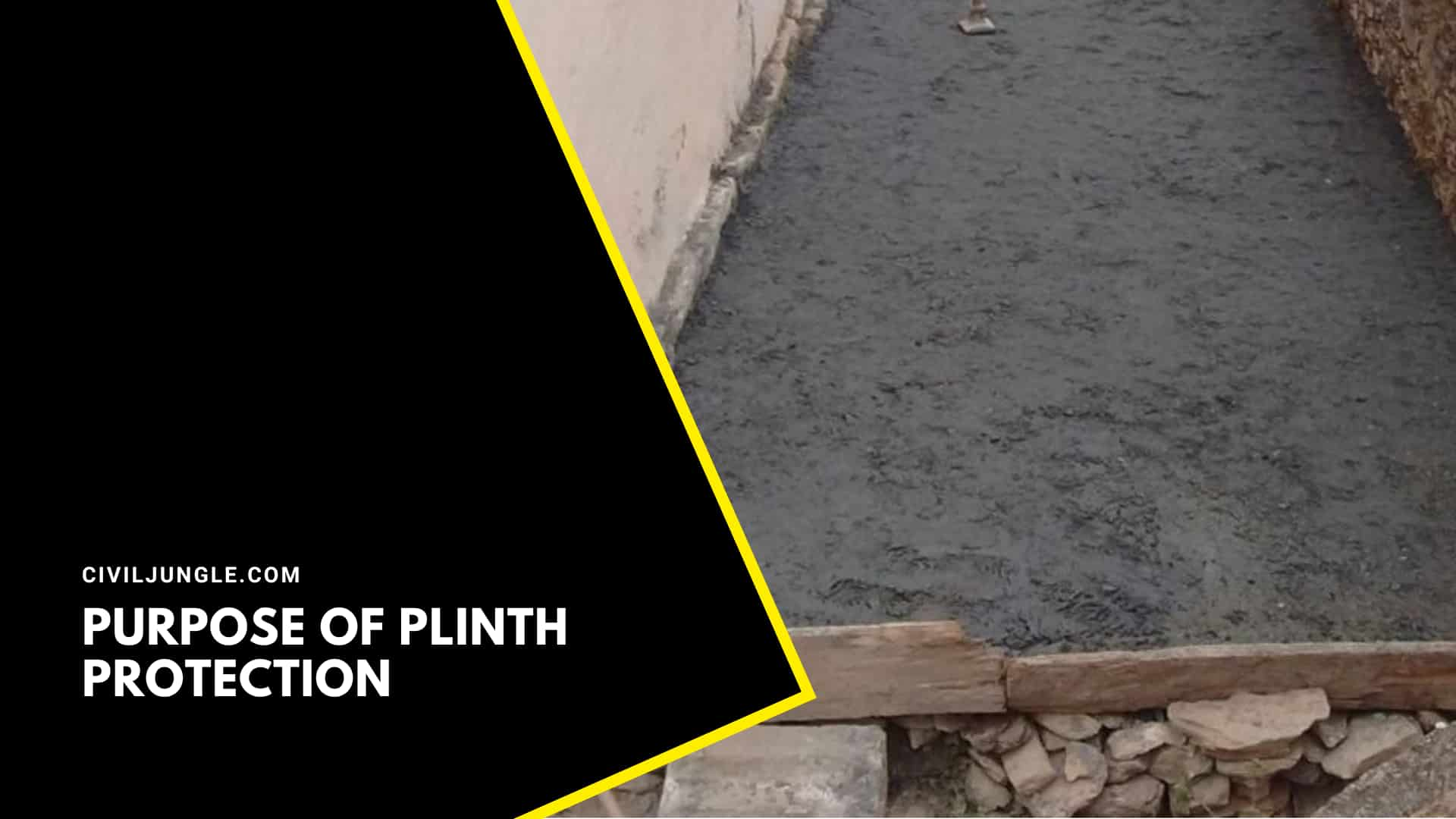What Is Plinth?
Important Point
A plinth is a base or platform that supports a plinth, column, or structure. Structurally, the plinth distributes weight and pressure down evenly across a column across a wider space.
You can also elevate structures above the ground to protect them from water or other elements.
What Is Height of Plinth?
The height of the plinth is between 300 – 450 mm from the ground level. It is recommended that a minimum baseboard height of 150 mm be adopted from a natural level.
Also, read: Brick Masonry | Types of Bricks | Types of Brick Masonry Work
Plinth Beam and Its Purpose in a Building?
The plinth beam is a reinforced concrete beam built between the wall and its foundation. The plinth beam is provided to prevent the extension or cracking of the foundation cracks in the wall above when the foundation suffers from laying.
Plinth beams evenly distribute the load from the wall over the foundation.
In a skeletal system, which is the other name for a framed structure, the plinth beam is the first beam to be built after the foundation.
How the ground floor finish level is maintained above ground level; the empty space and the void are filled with compacted soil, in order to obtain a stable surface for the floor to be built.
Also, read: What Is Contour Interval | Calculation of Contour Intervals | Uses of Contour Intervals in Surveying
Plinth Beam Applications
It is mandatory to provide a Purpose radius in areas prone to earthquakes.
The construction of the plinth board beam above the natural soil is another application of this type of beam.
Concrete Strength Suitable for Construction of Plinth Beam
The concrete strength of the plinth board beam must not be less than 20MPa.
If the concrete is mixed manually, it will be necessary to add an additional 20% of cement to the mixture.
Minimum Dimension of Plinth Beam
The minimum depth of the plinth beam is 20 cm, while its width must match the width of the final stroke of the foundation.
Formwork for Plinth Beam
The formwork used for the construction of plinth beams must be installed and fastened properly before laying the concrete, as shown in below pic. The concrete needs to be compacted enough to avoid steel bars against aggressive elements.
Steel Bars Used for Plinth Beam
It is recommended to provide two bars with a minimum diameter of 12 mm at the bottom of the beam. Likewise, two bars with a minimum diameter of 10 mm must be provided at the top of the plinth beam.
The reinforcement bars must be protected by a 25 mm concrete cover. With regard to the stirrups, the diameter of the stirrup must be at least 6 mm, and the spacing of 15 cm must be sufficient.
What Is Plinth Protection?
Plinth protection reduces direct water from entering into the soil close to the plinth wall. In other words, the area surrounding the building is usually known as plinth protection.
Plinth protection usually is done by pouring an approximate 75 – 100 mm layer of plain cement concrete along the edge of the building.
The protection of the plinth is necessary to prevent/reduce the infiltration of water in the soil that reaches the plinth wall and reaches the floor level by capillary action.
The plinth beam protection reduces the direct entry of water into the ground near the plinth board wall.
In technical terms, the area around the building is generally known as plinth protection. The plinth protection is usually done by pouring a layer of approximately 100 mm of common cement concrete along the edge of the building.
The main idea behind this is to prevent water retention along the edge of the building, thus ensuring a long service life.
In most basic buildings, the protection of the plinth is usually left exposed for viewing.
However, in the case of well-finished buildings, the plinth beam protection can be covered with a layer of sidewalk blocks, gravel, or even the surrounding lawn.
The protection of the plinth is necessary to prevent/reduce the infiltration of water in the soil that reaches the plinth wall and reaches the floor level by capillary action.
The plinth board protection reduces the direct entry of water into the ground near the plinth board wall. In other words, the area around the building is generally known as plinth protection.
However, in the case of well-finished buildings, the plinth board protection can be covered with a layer of sidewalk blocks, gravel, or even the surrounding lawn.
Note: The plinth board protection is provided to prevent the extension or spread of cracks in the foundation on the wall above when the foundation is laid. If water is seeping into the ground.
Also, read: What Is Cinder Block | Cinder Block Properties | Shapes of Cinder Blocks |Advantages of Cinder
Purpose of Plinth Protection
The protection of the plinth is necessary to prevent/reduce the infiltration of water in the soil that reaches the plinth wall and reaches the floor level by capillary action.
The plinth board protection reduces the direct entry of water into the ground near the plinth beam wall.
The plinth beam in a frame structure is intended to join all columns, thereby reducing the effective length and thus reducing the slenderness of the columns.
Skirting beams are generally used in case the foundations are a little deeper and thus act as a reinforcement or mooring element.
One more reason to provide a plinth beam is to avoid differential settlement in a building, due to the reason that the entire load of the wall is carried by the skirting beam underneath.
Also, read: WPC Board | Features of WPC Board | Disadvantages of the WPC board | Usw of WPC
How Do You Make Plinth Protection?
The protection of the plinth is usually done by pouring a layer of approximately 100 mm of common cement concrete along the edge of the building.
The main idea behind this is to prevent water retention along the edge of the building, thus ensuring a longer life.
Plinth Wall
A plinth level forms the foundation of a house. It is a rectangular block of stone on which a column and pillar of a building stands. It is a wall between the ground level and the ground floor level. The main function of a plinth in construction is to distribute the load of the columns over the foundation evenly.
What Is Plinth Beam?
Plinth beam is a reinforced concrete beam constructed between the wall and its foundation. Plinth beam is provided to prevent the extension or propagation of cracks from the foundation into the wall above when the foundation suffers from a settlement.
Plinth Foundation
A plinth level forms the foundation of a house. It is a rectangular block of stone on which a column and pillar of a building stands. It is a wall between the ground level and the ground floor level. The main function of a plinth in construction is to distribute the load of the columns over the foundation evenly.
Plinth Design Ideas for Home Exteriors
here are some plinth design ideas for home exteriors that you might find appealing:
- Natural Stone Plinth: Use locally sourced natural stone to create a sturdy and elegant plinth. The texture and color variations of the stone can add character to your home’s exterior.
- Brick Accents: Incorporate bricks into your plinth design, either as a solid base or in a decorative pattern. This can add a touch of warmth and timeless charm to your home’s appearance.
- Wooden Plinth with Railing: Combine a wooden plinth with a decorative railing or balustrade. This design can create a classic and inviting look for your home.
- Concrete with Geometric Patterns: Pour concrete for the plinth and imprint it with geometric patterns or textures for a modern and visually intriguing effect.
- Raised Plinth with Landscaping: Elevate your home slightly with a raised plinth and integrate landscaping elements, like small shrubs or flowers, around the base for a harmonious connection between the building and its surroundings.
Benefits of Using Plinths in Architectural Projects
Here are some key advantages of using plinths in architectural design:
- Elevated Aesthetics: Plinths can enhance the visual appeal of a building by creating a distinct and attractive base. They serve as a transition between the ground and the building’s main structure, adding architectural interest and curb appeal.
- Architectural Identity: Plinths can define the architectural identity of a structure, emphasizing its style and historical significance. They are particularly useful in classical and traditional architecture where the base of a building carries symbolic and stylistic significance.
- Protection and Durability: Plinths provide protection to the lower portion of a building’s exterior by elevating it above ground level. This helps prevent water damage, moisture infiltration, and other environmental factors that could affect the building’s structural integrity over time.
- Structural Stability: Plinths offer a stable foundation for the rest of the structure. They distribute the weight of the building more evenly, especially in areas with uneven terrain or soil conditions. This can reduce the risk of settlement and shifting over time.
- Transition and Scale: Plinths help manage the transition between the building and the surrounding landscape or environment. They can smooth out elevation changes, making the building appear more integrated into its surroundings and appropriately scaled.
Benefits of Using Plinths in Architectural Projects
Here are some key advantages of using plinths in architectural design:
- Elevated Aesthetics: Plinths can enhance the visual appeal of a building by creating a distinct and attractive base. They serve as a transition between the ground and the building’s main structure, adding architectural interest and curb appeal.
- Architectural Identity: Plinths can define the architectural identity of a structure, emphasizing its style and historical significance. They are particularly useful in classical and traditional architecture where the base of a building carries symbolic and stylistic significance.
- Protection and Durability: Plinths provide protection to the lower portion of a building’s exterior by elevating it above ground level. This helps prevent water damage, moisture infiltration, and other environmental factors that could affect the building’s structural integrity over time.
- Structural Stability: Plinths offer a stable foundation for the rest of the structure. They distribute the weight of the building more evenly, especially in areas with uneven terrain or soil conditions. This can reduce the risk of settlement and shifting over time.
- Transition and Scale: Plinths help manage the transition between the building and the surrounding landscape or environment. They can smooth out elevation changes, making the building appear more integrated into its surroundings and appropriately scaled.
Top Materials for Durable Plinths in Construction
When selecting materials for durable plinths in construction, it’s important to consider factors such as weather resistance, strength, aesthetics, and maintenance requirements. Here are some top materials commonly used for durable plinths:
- Natural Stone: Natural stones like granite, limestone, and sandstone are highly durable and provide a timeless, elegant appearance. They can withstand various weather conditions and require minimal maintenance. Natural stone plinths can add a sense of permanence and character to a building’s exterior.
- Concrete: Concrete is a versatile and durable material that can be shaped into various forms and finishes. It’s resistant to weather, pests, and fire. Decorative concrete can be stamped, stained, or textured to mimic the appearance of other materials while offering superior longevity.
- Brick: Brick plinths are durable and can complement a variety of architectural styles. They are resistant to weather and pests, and they require minimal maintenance. Brick plinths can be left exposed for a classic look or painted to match the building’s color scheme.
- Precast Concrete: Precast concrete plinths are manufactured off-site, ensuring consistent quality and durability. They can be customized with various finishes and textures. Precast concrete offers a streamlined construction process and excellent longevity.
- Stone Veneer: Stone veneer is a cost-effective alternative to natural stone. It consists of thin slices of natural or manufactured stone adhered to a substrate. It provides the appearance of stone while being lighter and more affordable.
Plinth Protection Against Moisture and Foundation Damage
A plinth protection usually is done by pouring approximately 75 – 100 mm layer of plain cement concrete along the edge of the building. Image 1: Gardening and watering outside the building which is lacking in a plinth protection causes water to enter the building through the masonry wall.
Innovative Uses of Plinths in Modern Landscape Design
Here are some innovative ways to incorporate plinths in your landscape design:
- Outdoor Sculpture Display: Use plinths to showcase sculptures or art installations in your landscape. Elevated sculptures can become focal points that draw attention and create a dynamic visual experience.
- Planter Bases: Place large planters on plinths to elevate and highlight your favorite plants or trees. This adds height variation to the landscape and emphasizes the greenery.
- Floating Seating: Design plinths with built-in seating areas, creating an illusion of “floating” benches or seats. These can provide comfortable seating while adding a modern and intriguing design element.
- Water Features: Incorporate plinths into your water features, such as fountains or cascading water walls. Plinths can serve as pedestals for water elements, adding architectural interest to the design.
- Functional Surfaces: Use plinths as functional surfaces, such as tables, counters, or display areas. These platforms can be used for outdoor dining, entertaining, or showcasing decorative items.
What Is a Plinth?
A plinth is a base or platform that supports a pedestal, column, or structure.
Plinth Meaning
plinth (pl. plinths) A block or slab upon which a column, pedestal, statue or other structure is based.
Plinth Meaning in Construction
In architecture, a plinth is one of the basic building elements. While it’s most common for a plinth to support a pillar or column, it can also be used as a base or slab underneath a statue, a bust, or a decorative vase, and in engineering a plinth is the support for a dam.
What Is Plinth Beam?
Plinth beam is a reinforced concrete beam constructed between the wall and its foundation. Plinth beam is provided to prevent the extension or propagation of cracks from the foundation into the wall above when the foundation suffers from settlement.
What Is Plinth in Civil Engineering?
A plinth beam is a rectangular stone block that supports a building’s pillars and subcolumns. A reinforced concrete plinth beam is built between the wall and its foundation during construction. A plinth beam is a rectangular stone block that supports the pillars and sub-columns of a building.
Types of Plinth
- Unit material plinths.
- Door material plinths.
- Mirrored plinths*
- Skirting boards.
Plinth Synonym
an architectural support or base (as for a column or statue) synonyms: footstall, pedestal.
Like this post? Share it with your friends!
Suggested Read –






hello sir very nice information really helpfull
nice info sir